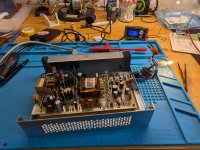mikerofone
Experienced Member
Hi all,
(TL;DR: My Profile got more and more unreliable in the last two years: It worked fine two years ago, then sat for the better part of a year after which it required multiple power-off/power-on cycles to initialize properly. After an additional 20h of runtime Lisa started crashing more and more while loading / putting away programs, and now the drive no longer initializes or performs its selftest at all. Now the drive spins up and may move the heads for a second, the busy LED might be on or off, and maybe after 20-60 seconds it will move the heads a bit and the LED resets as if the init routine restarted and failed again.
I measured the voltages recently and the 5V rail was at about 4.39V - way too low and that might explain why the drive controller is malfunctioning. I assume the voltages kept sinking over time which is why the drive gradually became more unreliable. I took some pictures of the PSU internals and there is some suspicious black gunk or charring on the PCB close to / under whatever that big heatsinked flat silver component is. My first thought was bad or leaky caps, but before I go recapping the entire thing I wanted to check whether there's any usual suspect caps in Profile PSUs that typically fail. (Besides the RIFAs obviously, which I discovered to my great horror were not replaced by the seller even though he mentioned "necessary caps replaced" when seeling the kit.)
I see that most if not all are Nippon Chemicon SXA series caps, which I've seen a lot in similar vintage gear, and I don't remember seeing these spill their guts. Can't say the same about those Nichicon PL(M) series caps I've met in various places...
There also seems to be some discoloration of the PCB under and around that gunk. As someone who knows way too little about PSUs, could that indicate a problem somewhere else in the circuit which maybe damaged the caps, instead of the caps failing on their own?
Thanks for any insights you might have!
Cheers
mikerofone
(TL;DR: My Profile got more and more unreliable in the last two years: It worked fine two years ago, then sat for the better part of a year after which it required multiple power-off/power-on cycles to initialize properly. After an additional 20h of runtime Lisa started crashing more and more while loading / putting away programs, and now the drive no longer initializes or performs its selftest at all. Now the drive spins up and may move the heads for a second, the busy LED might be on or off, and maybe after 20-60 seconds it will move the heads a bit and the LED resets as if the init routine restarted and failed again.
I measured the voltages recently and the 5V rail was at about 4.39V - way too low and that might explain why the drive controller is malfunctioning. I assume the voltages kept sinking over time which is why the drive gradually became more unreliable. I took some pictures of the PSU internals and there is some suspicious black gunk or charring on the PCB close to / under whatever that big heatsinked flat silver component is. My first thought was bad or leaky caps, but before I go recapping the entire thing I wanted to check whether there's any usual suspect caps in Profile PSUs that typically fail. (Besides the RIFAs obviously, which I discovered to my great horror were not replaced by the seller even though he mentioned "necessary caps replaced" when seeling the kit.)
I see that most if not all are Nippon Chemicon SXA series caps, which I've seen a lot in similar vintage gear, and I don't remember seeing these spill their guts. Can't say the same about those Nichicon PL(M) series caps I've met in various places...
There also seems to be some discoloration of the PCB under and around that gunk. As someone who knows way too little about PSUs, could that indicate a problem somewhere else in the circuit which maybe damaged the caps, instead of the caps failing on their own?
Thanks for any insights you might have!
Cheers
mikerofone

